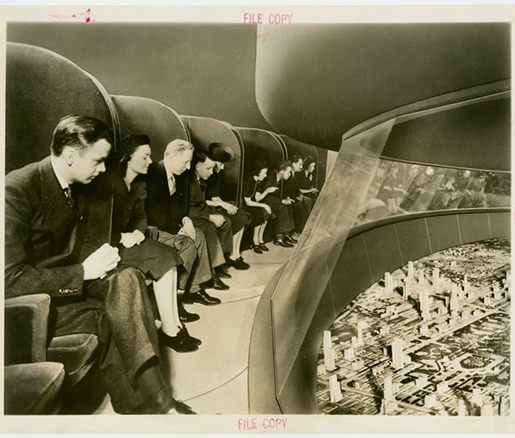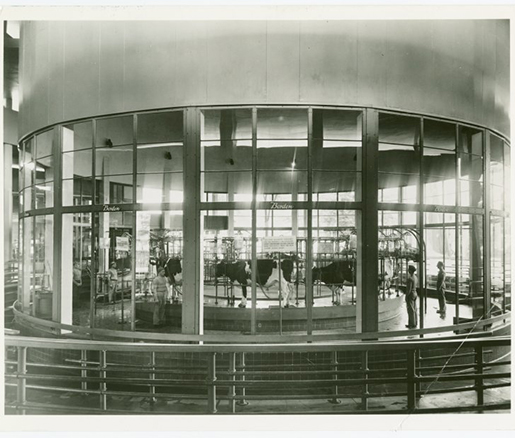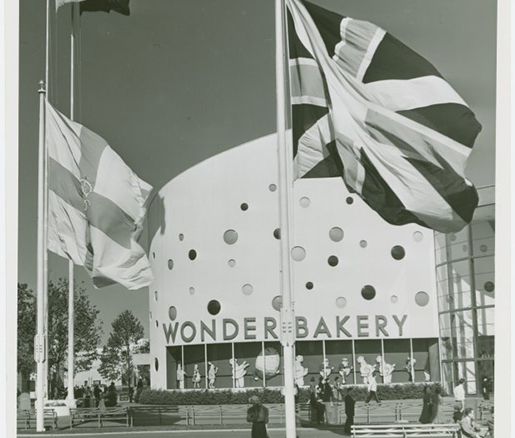In honor of our role in Expo Milano 2015, we’re taking a look back at the history of food at world’s fairs. After her whirl through the 1893 Chicago Exposition, JBF assistant editor Maggie Borden is now taking us back to 1939, when the New York World’s Fair ran for six months in Flushing Meadows-Corona Park, and where a young Mimi Sheraton delighted in new flavors and futuristic sights.

Taylor Pork Roll. That’s what acclaimed food, design, and travel writer Mimi Sheraton remembers from the 1939 New York World’s Fair.
Initially conceived by local businessmen to raise the city (and the nation) out of the depths of the Great Depression, the fair was the first to focus on the future, coalescing around the theme “The World of Tomorrow.” Located in Flushing Meadows-Corona Park, the fair introduced many Americans to both new technology and a wide range of international cultures, and it’s no surprise that food played a large part of that introduction. Running from April 30, 1939, to October 27, 1940, the fair saw 44 million visitors in total, including a teenage Mimi Sheraton, who was gracious enough to share the wondrous sights (and tastes) that have stuck with her all these decades later.
The Fair’s “Dawn of a New Day” slogan encompassed a wide range of promises for a bright new future. The 1939 Exposition featured the first public displays of color photography, nylon, air conditioning, fluorescent lamps, the View-Master, and Smell-O-Vision, as well as full-scale mechanized exhibits from national industry leaders like IBM, RCA, and General Electric. Sheraton specifically remembers the Futurama exhibit from General Motors, which took visitors on a ride over a massive diorama of an American city of the future. “You sat in a chair and rotated around the globe—it was supposed to be 24 hours over what would be a model village, very much the way Levittown turned out to be, little houses and little streets, and all automatic kitchens. It was quite beautiful, the way they had the sun come up and the sun set. It was going to be a perfectly marvelous, orderly, clean world.”
Explorations of progress and diversity were not limited to just the world of industry and architecture. As with previous expositions, food played a very prominent role at the 1939 Fair, appearing not only in a dedicated Food Zone, but also in the myriad international pavilions showcasing their native cuisines.
The Food Zone showcased the latest technology and products from American companies, and featured many brands still found on store shelves today. The exhibit for Borden’s Milk featured 150 cows on a “Rotolactor” that mechanically bathed, dried, and milked them, while Coca-Cola demonstrated the inner workings of a bottling plant, and Kraft revealed how the modern pasteurization process was used for Philadelphia Cream Cheese. Continental Baking planted an entire field of wheat behind their exhibit, which was housed in a building shaped like a package of their best-known product, Wonder Bread, complete with the trademark red, blue, and yellow balloons.

But what Sheraton best recalls are the companies that handed out samples. In fact, she was so enamored with the New Jersey staple Taylor Pork Roll, she begged her mother to remake it at home: “it was something like a luncheon meat, a little firmer, a little harder, but in a sausage shape, almost a baloney-sized sausage. They demonstrated it and gave you samples, but they always grilled it on both sides. So I went home and wanted my mother to buy Taylor Pork Roll, so we could fry it.”
Other new marvels of food innovation that caught her eye were the Nabisco Icebox Cake (“I guess it was chilled because people didn’t have freezers then. Unless they wanted you to put it in the ice cube compartment”) and Post shredded wheat (“it made me think ‘I have to eat shredded wheat.’ And I still like it. I still eat shredded wheat!”). She also looks back fondly on the Heinz Dome, which featured animated stage shows like “The Story of Strained Baby Food,” and “The Aristocrat Tomato Man,” and gave out small souvenir pins in the shape of tiny pickles.
For all the fun and frivolity of the Food Zone’s displays, the World’s Fair visitors could not escape the troubling conflicts of the period gradually emerging across the globe. 1939 New York World’s Fair arrived at a time of great transition. Its initial goals of promoting connection and brotherhood among the international community unintentionally served as ironic contrasts to the escalating turmoil in Europe. Over the course of its two-year run, the event served as a visual marker of the march of Hitler and his allies across the Continent, as the pavilions of conquered nations like Poland and Czechoslovakia were forced to close prematurely. The theme of the fare was changed to “For Peace and Freedom” for the 1940 season, and even at the age of thirteen, Sheraton remembers the tragic contrast of the Fair’s slogan and the war unfolding across the Atlantic. From newsreels to radio broadcasts, Americans heard, as Mimi described, “Hitler screaming across the ocean. Nobody could understand what he was saying, but that whole summer was just imminent doom. I went to the beach everyday, and when you changed in the lockers people had portable radios on and everyone was listening.” The bright promise of the future suddenly seemed a whole lot darker.

However, one unexpected silver lining was the influx of talented foreign food professionals who ended up remaining in the U.S. to avoid the dangers back home. The popular French Pavilion, whose restaurant Le Restaurant du Pavillon de France earned great acclaim during the World’s Fair, ultimately gave birth to three of New York City’s most prestigious French restaurants: La Caravelle, La Côte Basque, and Le Pavillon, opened by Le Restaurant’s Maitre’d Henri Soulé and chef Pierre Franey in 1941. Eventually employing luminaries like a young Jacques Pepín, these restaurants helped to shape the postwar dining landscape of New York City, catering to a climate of returning GIs and the increasingly availability of international travel.
Even with the tragic pall cast by the encroachment of the Second World War, the 1939 World’s Fair ultimately promoted the promise of progress and humanity’s ability to make a better future. The enduring legacy of the Fair is visible all around us – in the technology of our cities and cell phones, the treaties and trade agreements that bridge our continents and seas, the burritos and banh that make up our lunches. For Mimi Sheraton, however, the fair’s greatest gift came from seeing so many foreign cultures and customs, which stoked the flames of her already burgeoning dream of travel. Quoting Robert Louis Stevenson’s poem “Travel,” Sheraton described her life’s goal: “it begins ‘I would like to rise and go where the golden apples grow.’ That’s been ringing in my mind ever since, and I’ve been rising and going and searching for golden apples.” That, and a taste for Taylor ham.
Images courtesy of NYPL Library Manuscripts and Archives Division.
--

View our complete archive of Expo Milano coverage. For more information about USA Pavilion, visit USAPavilion2015.net and follow @USAexpo2015 on Twitter. To learn more about Expo Milan, visit expo2015.org/en and follow @Expo2015Milano.
Maggie Borden is assistant editor at the James Beard Foundation. Find her on Twitter and Instagram.






